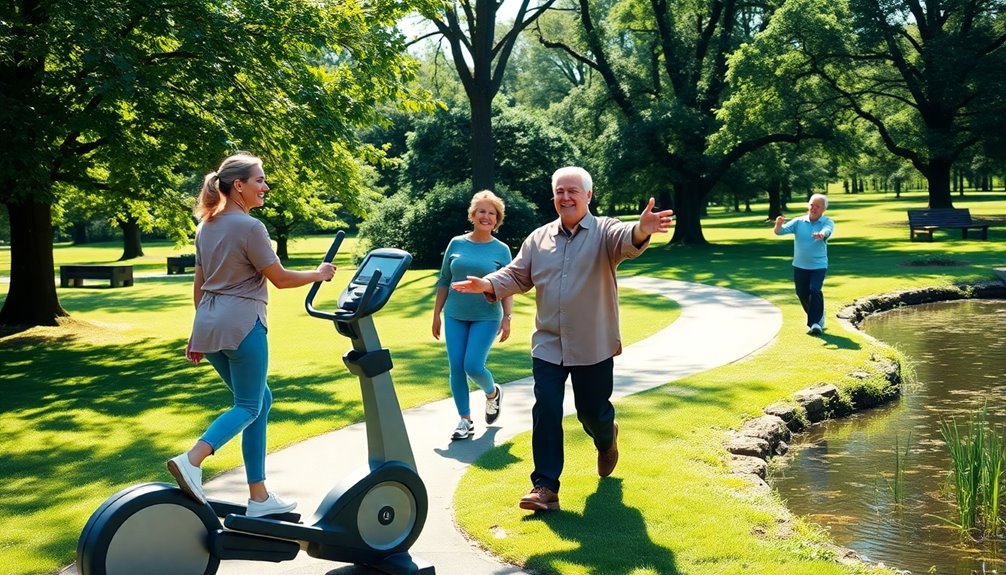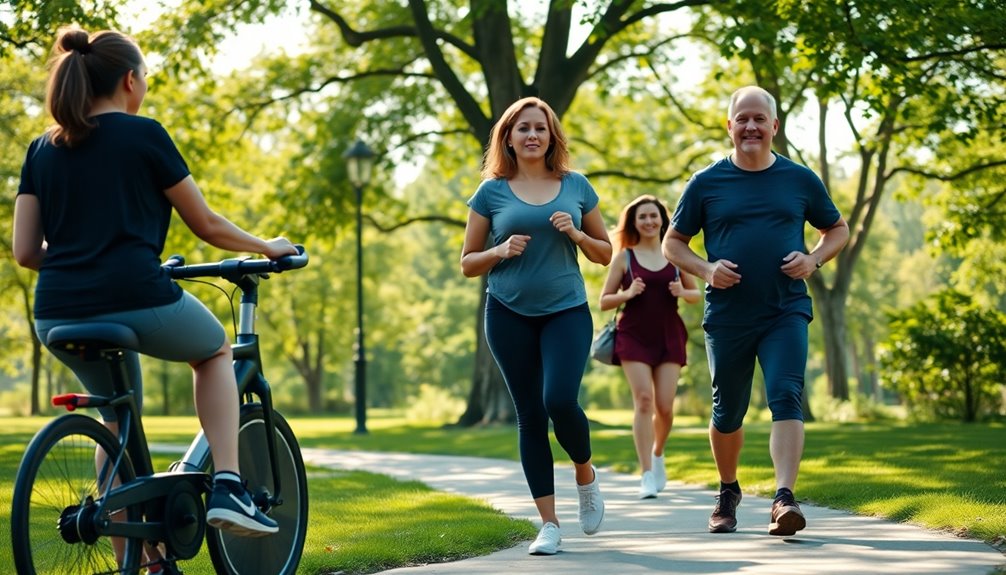Low-impact cardio is essential for your joint health. Activities like walking, swimming, and cycling strengthen the muscles surrounding your joints, reducing inflammation and discomfort. They also enhance blood flow, which keeps your joints nourished and flexible. Plus, low-impact exercises improve your overall mobility and range of motion, making daily tasks easier. You don't have to worry about overexertion, as these activities suit all fitness levels and can be adjusted to your pace. Incorporating low-impact cardio into your routine can greatly benefit your long-term joint health. Discovering how to incorporate these exercises effectively can take your fitness to the next level!
Key Takeaways
- Low-impact cardio strengthens surrounding muscles, providing better support for joints and reducing the risk of injury.
- Activities like walking and swimming enhance blood flow to joints, promoting overall joint health and reducing inflammation.
- Engaging in low-impact cardio improves flexibility and range of motion, which helps reduce joint stiffness and discomfort.
- Regular low-impact exercise promotes cardiovascular fitness, which is crucial for maintaining long-term joint health and mobility.
- Low-impact cardio is suitable for all fitness levels, encouraging consistent participation and sustainable habits for joint maintenance.
Understanding Low-Impact Cardio

Low-impact cardio is like a gentle breeze for your joints, providing a great way to stay active without the stress that high-impact exercises often cause. If you're looking for low impact options, you'll find that these exercises can be both enjoyable and effective. The beauty of low-impact cardio lies in its ability to keep your heart rate up while being kind to your body.
You might be wondering what kinds of joint-friendly exercises fit into this category. Activities like walking, swimming, cycling, or using an elliptical machine are all excellent choices. They allow you to work up a sweat without the jarring effects of running or jumping. This makes them perfect for anyone, whether you're just starting your fitness journey or you're recovering from an injury.
Choosing low-impact options doesn't mean you have to sacrifice intensity. You can easily adjust your pace and resistance level to challenge yourself. Plus, these exercises can be done in a variety of settings—at home, in a gym, or even outdoors. You're part of a community that values movement, and low-impact cardio lets you join in without feeling left out. Additionally, incorporating mini bands into your routine can enhance the effectiveness of your workouts by providing effective muscle toning without adding joint pressure.
Benefits for Joint Health

When it comes to maintaining joint health, engaging in low-impact cardio can make a significant difference over time. By incorporating activities like swimming, cycling, or walking into your routine, you can enjoy numerous benefits that promote joint protection and pain reduction. These activities are gentle on your joints while still providing a solid workout.
Low-impact cardio helps strengthen the muscles surrounding your joints, which is essential for stability and support. This added strength can lead to less wear and tear on your joints, reducing the risk of injury. Additionally, regular low-impact workouts can help keep your body weight in check, further alleviating stress on your joints. Studies have shown that regular exercise can also improve overall metabolic health, which is crucial for managing conditions like diabetes.
Here's a quick look at how low-impact cardio can benefit you:
| Benefit | How It Helps | Emotional Impact |
|---|---|---|
| Joint Protection | Strengthens surrounding muscles | Feel secure and confident |
| Pain Reduction | Lowers inflammation and discomfort | Experience relief and freedom |
| Improved Circulation | Enhances blood flow to joints | Boosts mood and energy levels |
| Accessibility | Suitable for all fitness levels | Encourages community and belonging
Improved Mobility and Flexibility

Improved mobility and flexibility are crucial for maintaining an active lifestyle, and low-impact cardio plays a significant role in achieving these goals. When you engage in low-impact activities like swimming, cycling, or walking, you're not just safeguarding your joints; you're also enhancing your body's overall function. These exercises encourage your muscles and joints to work together smoothly, leading to an increased range of motion.
As you incorporate low-impact cardio into your routine, you'll likely notice reduced stiffness in your joints. This is particularly important as we age or if you've experienced injuries in the past. When your joints move freely, it allows you to perform daily activities with greater ease, whether it's bending down to tie your shoes or reaching for something on a high shelf.
Furthermore, low-impact cardio is an excellent way to warm up your body before more intense workouts or activities. It gradually prepares your muscles and joints for movement, reducing the risk of injury. Additionally, incorporating glute-specific movements can further enhance your overall movement efficiency and performance.
Plus, the gentle nature of these exercises makes them accessible for everyone, regardless of fitness level.
Enhanced Cardiovascular Fitness

Engaging in low-impact cardio not only helps with mobility and flexibility but also greatly enhances your cardiovascular fitness. When you choose activities like swimming, cycling, or brisk walking, you're giving your heart a workout without putting excessive stress on your joints. This makes it easier for you to stay consistent and engaged, which is essential to reaping the benefits.
As you incorporate low-impact exercises into your routine, you'll notice your increased endurance over time. Your heart will become more efficient at pumping blood, which means you'll feel more energetic during your daily activities. This boost in energy can lead to a more active lifestyle, fostering a sense of community, whether it's walking with friends or joining a yoga class.
Moreover, focusing on heart health is vital for overall well-being. Low-impact cardio helps lower your risk of heart disease by improving circulation and reducing blood pressure. Additionally, engaging in regular exercise can significantly reduce the likelihood of developing alcohol use disorder, promoting a healthier lifestyle overall.
When your heart works better, you're not only feeling good physically but also mentally. You'll gain confidence in your abilities and a sense of accomplishment as you reach your fitness goals.
Injury Prevention Strategies

Incorporating injury prevention strategies into your low-impact cardio routine is necessary for maintaining joint health and maximizing your workout benefits. A proper warm-up can make a world of difference in preparing your body for exercise. Spending 5 to 10 minutes engaging in dynamic stretches or light aerobic activities increases blood flow to your muscles and joints, reducing the risk of strains and sprains. Don't underestimate this essential step; it sets the tone for a safe and effective workout.
Another key element is integrating cross training techniques into your routine. By alternating between different types of low-impact cardio, like cycling, swimming, or using an elliptical, you can prevent overuse injuries and guarantee that various muscle groups are being strengthened. This variety not only keeps your workouts fresh and exciting, but it also helps to build balanced strength and flexibility, which are vital for joint health.
Listening to your body is equally important. If you feel any discomfort or pain, don't push through it. Instead, take a break or modify your routine to allow for recovery. Remember, it's about finding a sustainable balance that works for you.
Tips for Incorporating Low-Impact Cardio

Finding ways to include low-impact cardio in your routine can enhance both your fitness level and joint health. Whether you're just starting out or looking to switch things up, there are plenty of options to fit your lifestyle and keep you moving without putting stress on your joints.
Start with joint-friendly exercises that you enjoy. Activities like swimming, cycling, or using an elliptical trainer can provide a solid workout without the harsh impact of running.
If you're attending a fitness class, don't hesitate to ask for low impact modifications. Instructors are often happy to offer alternatives that will make the workout more accessible for you.
Consider incorporating short bursts of low-impact activities throughout your day. A quick 10-minute walk, some gentle stretching, or even a few minutes on a stationary bike can keep your body engaged and support your joint health.
Aim for consistency rather than intensity; it's about building a habit that feels good and works for you. Engaging in pre-habilitation techniques can also help strengthen the areas around your joints, further supporting your overall health.
You can also explore online resources or fitness apps that focus on low-impact workouts. They often provide structured plans and video demonstrations, making it easier to stay motivated and connect with a community of like-minded individuals.
Lastly, listen to your body. If something doesn't feel right, don't push through the discomfort. Remember, the goal is to move in a way that feels good while protecting your joints.
Embrace the journey and enjoy the process of discovering what works best for you!
Frequently Asked Questions
Can Low-Impact Cardio Help With Weight Management?
Yes, low-impact cardio can definitely help with weight management. When you engage in activities like swimming or cycling, you burn calories without putting too much stress on your joints. This supports weight loss while also boosting your cardiovascular health.
You'll find that consistent low-impact workouts can create a sustainable routine, making it easier to stick with your goals. Plus, you'll feel a sense of community as you exercise alongside others who share your journey.
Is Swimming Considered Low-Impact Cardio?
While running can strain your joints, swimming offers a revitalizing alternative. It's considered low-impact cardio because the water supports your body, reducing stress on your joints. Swimming benefits you by enhancing cardiovascular fitness without the harsh impact of other exercises.
Plus, it's a joint-friendly exercise that allows you to build strength and endurance while staying cool. So, immerse yourself in the pool and enjoy a workout that's gentle yet effective for your body!
How Often Should I Do Low-Impact Cardio?
To get the most from low-impact cardio, aim for at least 150 minutes a week, spread across several sessions. You can break it down into 30 minutes, five days a week. Adjust the intensity levels to match your fitness goals—whether you're looking for a brisk walk or a leisurely swim, make sure it feels right for you.
Consistency is key, so find a rhythm that fits your lifestyle and keeps you motivated!
What Equipment Is Best for Low-Impact Cardio?
When it comes to low-impact cardio, think of your workout as a smooth ride on a calm sea.
Elliptical machines and stationary bikes are your best vessels. The elliptical gives you a full-body workout while keeping your joints cushioned, like gliding on air.
Stationary bikes offer a solid cardiovascular boost without the impact. Both pieces of equipment can help you connect with others on the same fitness journey, creating a sense of belonging.
Can Low-Impact Cardio Be Done at Home?
Absolutely, you can do low-impact cardio at home! Home workouts can be both fun and effective, incorporating joint-friendly exercises like cycling on a stationary bike, using a jump rope, or dancing. These activities keep your heart rate up while being gentle on your joints.
Plus, you can customize your routine to fit your space and preferences, making it easy to stay motivated and connected with your fitness journey. Enjoy your workout!
Conclusion
Incorporating low-impact cardio into your routine is like planting seeds in a garden; with care and consistency, you'll watch your joint health bloom. By improving mobility, enhancing cardiovascular fitness, and reducing the risk of injuries, you're nurturing not just your joints but your overall well-being. So, lace up those sneakers and embrace activities like swimming, cycling, or brisk walking. Your joints will thank you, and you'll feel the difference in your everyday life.



